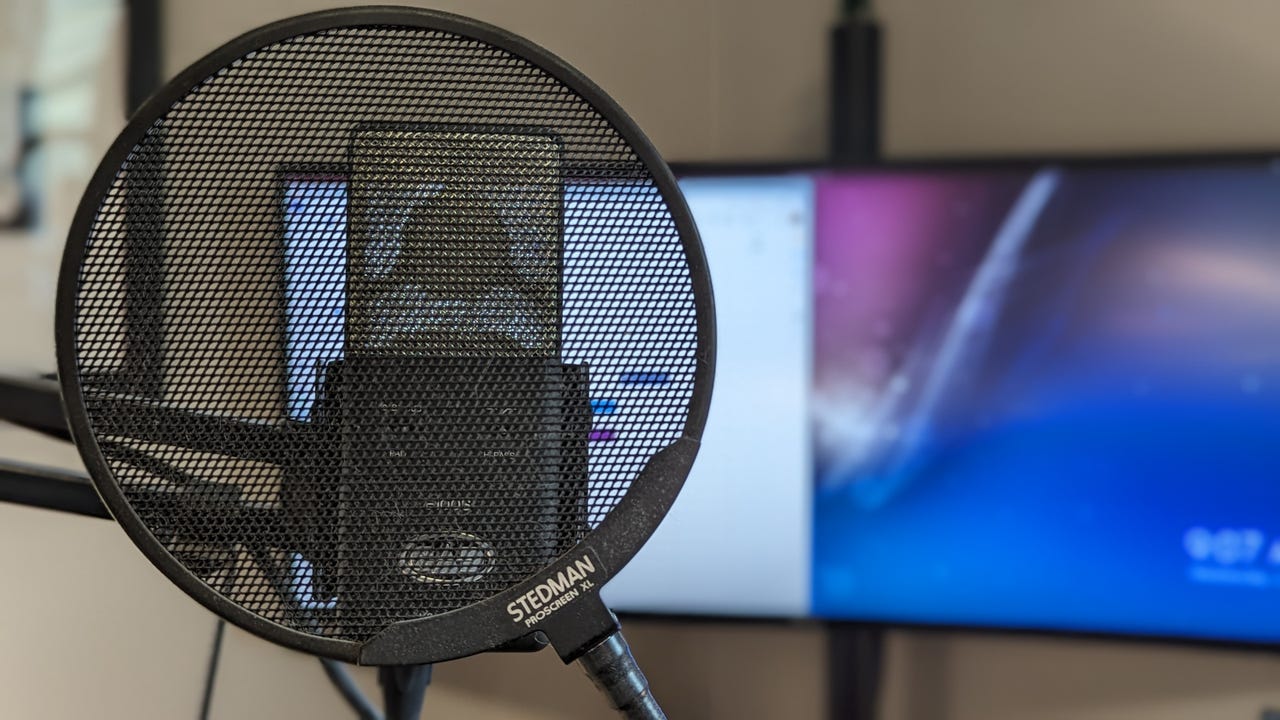[ad_1]

My Stedman Pro XL pop filter has served me well for many years. Jack Wallen/ZDNET
I’ve spent a lot of time in front of a mic over the years. Between podcasting, audiobook narration, and voice-overs, I can’t imagine how many hundreds of hours of recorded audio I’ve created. I’ve gone through different microphones, input devices, speakers, headphones, and cables…all in the name of improving my sound. Other than my mic and the acoustics of the room I’m recording in, there’s one piece of equipment that has done more to improve my sound and done so with simplicity and relative cost-effectiveness.
That piece of equipment is the pop filter.
Also: My go-to microphone for podcasting and streaming over the past decade
What is a pop filter?
Have you ever listened to a recording of yourself and felt as if you were punching your Ps, Bs, and other plosives a bit too hard? Or maybe you’re hearing too much break and various mouth noises?
Part of the reason for that is the sensitivity of your mic and how close your mouth is to it when recording. If you’re very close to the mic, the “explosion” of breath from your mouth registers and can sound like you’re hitting the Ps and Bs too hard. You can pull back on those by using less breath or stepping away from the mic a bit. The problem with either of those methods is that they feel unnatural — or your voice loses a bit of resonance. Personally, I like to get very close to my mic, so I can feel a bit of an intimate relationship with it (which translates to a richer, more immediate sound).
But by being so close to the mic, I’d really have to be careful with certain sounds. Or, I can employ a pop filter.
A pop filter is a screen placed between your mouth and the mic that redirects a lot of the air expelled from your mouth to prevent it from hitting that sensitive mic. With a pop filter, your Ps and Bs won’t sound so explosive and it can even reduce the breathing sounds and some mouth noises. It won’t remove mouth noise altogether, but it certainly helps. So don’t think a pop filter will prevent you from having to do any mouth noise removal in post. But without those overstated plosives, you’ll find that your recordings are much easier to polish.
If you’ve yet to purchase a pop filter, do yourself a favor and skip over all the competition and buy what many consider to be the industry standard — Stedman. This pop filter is a professional quality device that dramatically reduces plosive sounds and can be attached to any mic stand (traditional or boom) and even directly to some mics (depending on the design of said mic).
The Stedman I use is the Pro XL which has a 6″ diameter screen and a 13″ flexible gooseneck. With my Stedman in place, I can get very close to the mic (a mere inch from the screen) and most plosives are dramatically reduced.
Also: How to remove background noise in Audacity for better-sounding podcasts
The specs for the Stedman are minimal:
- Screen diameter: 6″
- Total length: 26.5″
- Weight: 10 oz.
- Clamp range: .39″
- Cost: $74.99 on Amazon
This pop filter will be the last one you ever purchase.
I have my Stedman clamped directly to my Rode booms stand and it stays tight. I can reposition the pop filter to accommodate the position of the mic without worrying that it will unclamp from the stand.
Here, you see how the Stedman clamps to a boom stand. Jack Wallen/ZDNET
How does the Stedman perform?
Simply put, I’ve used a number of different pop filters over the years and none of them compare to the Stedman Pro XL. The reduction of plosive noise found with the Stedman bests all other pop filters I’ve tried — by a long shot.
In fact, I started using the Stedman years ago and haven’t even considered trying another. This will be the last pop filter you’ll ever buy. It’s that good.
Also: These over-ear headphones sound like full-on speakers, and you can’t beat the price
Some might think the $74.99 cost is a bit high but given how much time you’ll save by not having to re-record because of too many plosives wreaking havoc on your recording, it’s money well spent.
In the end, if you’re a podcaster, audiobook narrator, or voice-over artist, you owe it to yourself to purchase a Stedman Pro XL pop filter.
[ad_2]
Source link

